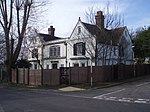Portsdown
Commons category link is locally definedSites of Special Scientific Interest in Hampshire

Portsdown is a 69.1-hectare (171-acre) biological Site of Special Scientific Interest on Portsdown Hill, on the northern outskirts of Portsmouth in Hampshire.This is a linear south-facing escarpment with a rich chalk grassland flora. The diverse insect fauna includes all the chalk downland butterflies and a population of the largest British bush cricket, Tettigonia viridissima. On the lower slopes, raised beaches indicate former sea levels.
Excerpt from the Wikipedia article Portsdown (License: CC BY-SA 3.0, Authors, Images).Portsdown
Leominster Road, Portsmouth Paulsgrove
Geographical coordinates (GPS) Address Nearby Places Show on map
Geographical coordinates (GPS)
| Latitude | Longitude |
|---|---|
| N 50.854 ° | E -1.092 ° |
Address
Leominster Road
Leominster Road
PO6 4BX Portsmouth, Paulsgrove
England, United Kingdom
Open on Google Maps







